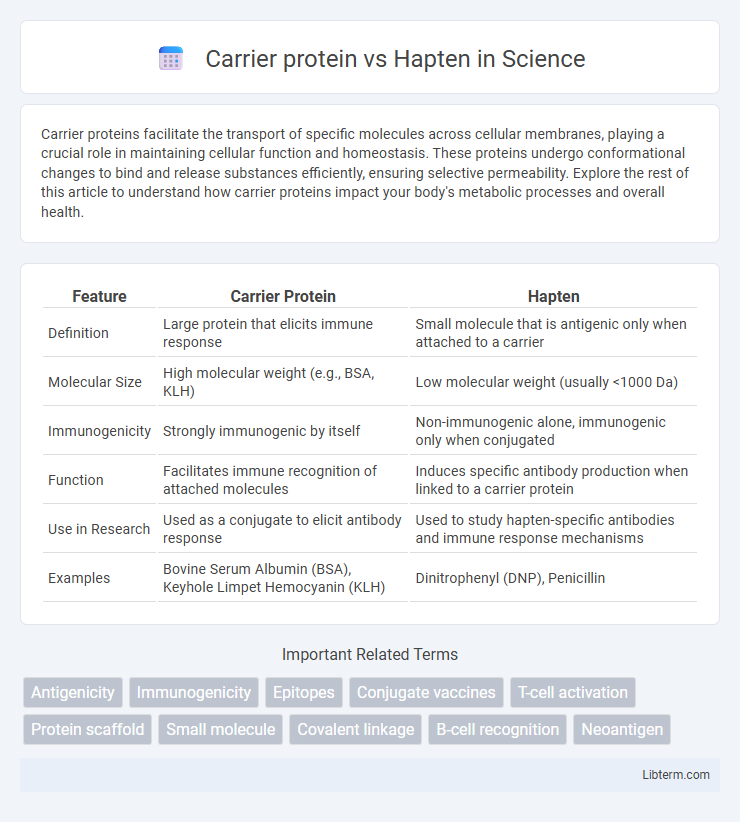Carrier proteins facilitate the transport of specific molecules across cellular membranes, playing a crucial role in maintaining cellular function and homeostasis. These proteins undergo conformational changes to bind and release substances efficiently, ensuring selective permeability. Explore the rest of this article to understand how carrier proteins impact your body's metabolic processes and overall health.
Table of Comparison
| Feature | Carrier Protein | Hapten |
|---|---|---|
| Definition | Large protein that elicits immune response | Small molecule that is antigenic only when attached to a carrier |
| Molecular Size | High molecular weight (e.g., BSA, KLH) | Low molecular weight (usually <1000 Da) |
| Immunogenicity | Strongly immunogenic by itself | Non-immunogenic alone, immunogenic only when conjugated |
| Function | Facilitates immune recognition of attached molecules | Induces specific antibody production when linked to a carrier protein |
| Use in Research | Used as a conjugate to elicit antibody response | Used to study hapten-specific antibodies and immune response mechanisms |
| Examples | Bovine Serum Albumin (BSA), Keyhole Limpet Hemocyanin (KLH) | Dinitrophenyl (DNP), Penicillin |
Introduction to Carrier Proteins and Haptens
Carrier proteins are large molecules that bind to smaller hapten molecules to elicit an immune response, as haptens alone are typically too small to be recognized by the immune system. Haptens are low-molecular-weight compounds that become immunogenic only when attached to a carrier protein, facilitating antibody production. This carrier-hapten conjugation is critical in vaccine design and immunological research for generating specific antibodies.
Defining Carrier Proteins
Carrier proteins are large molecules that bind to small antigens, known as haptens, to elicit a stronger immune response by facilitating antigen presentation. Unlike haptens, which are too small to be immunogenic on their own, carrier proteins such as bovine serum albumin (BSA) or keyhole limpet hemocyanin (KLH) provide the necessary molecular weight and complexity to trigger antibody production. This conjugation enables the immune system to recognize and generate antibodies against the hapten-carrier complex effectively.
Understanding Haptens
Haptens are small molecules that, when attached to a larger carrier protein, can elicit an immune response by forming a complete antigen complex. Unlike carrier proteins, which are immunogenic on their own, haptens are non-immunogenic alone but become antigenic due to the structural conjugation with the carrier protein. Understanding haptens is crucial in immunology for vaccine development and drug allergy testing, where the hapten-carrier protein interaction triggers the production of specific antibodies.
Structural Differences Between Carrier Proteins and Haptens
Carrier proteins are large, complex molecules typically composed of amino acid chains that provide a stable framework for the attachment of haptens, which are small, chemically distinct molecules incapable of eliciting an immune response on their own. Structurally, carrier proteins possess multiple epitopes and a high molecular weight, whereas haptens are low molecular weight compounds lacking immunogenicity unless conjugated to a carrier. The conjugation process forms a hapten-carrier complex that facilitates recognition by the immune system, leveraging the carrier's structural complexity to present the hapten effectively.
Mechanisms of Immune Recognition
Carrier proteins enable immune recognition by presenting haptens, which are small molecules that alone cannot elicit an immune response, to antigen-presenting cells (APCs). The immune system identifies the carrier protein's epitopes, facilitating T-cell activation and antibody production against the hapten-carrier complex. This mechanism is essential for generating a robust immune response to otherwise non-immunogenic haptens.
Biological Functions of Carrier Proteins
Carrier proteins facilitate the transport of molecules across cellular membranes, enabling essential nutrient uptake, waste removal, and signal transduction. They play a critical role in maintaining cellular homeostasis by selectively binding and transporting ions, small molecules, or metabolites. Unlike haptens, which are small molecules that elicit an immune response only when attached to a larger carrier, carrier proteins actively participate in biochemical processes essential for cell survival and function.
Role of Haptens in Immune Responses
Haptens are small molecules that, when attached to larger carrier proteins, become immunogenic and trigger an immune response by enabling the formation of hapten-carrier complexes recognized by antibodies. Carrier proteins provide the necessary structural framework to present haptens to the immune system, facilitating the activation of B cells and T cells. This interplay is crucial for understanding allergic reactions, vaccine design, and antibody production targeting small, non-immunogenic molecules.
Clinical Significance: Allergies and Drug Reactions
Carrier proteins play a crucial role in clinical immunology by enhancing the immunogenicity of haptens, which are small molecules that alone cannot elicit an immune response but cause allergic reactions when bound to these proteins. Haptens linked to carrier proteins can trigger hypersensitivity reactions, leading to drug allergies and adverse drug reactions in susceptible individuals. Understanding the interaction between carrier proteins and haptens is essential for developing safer pharmaceuticals and effective allergy diagnostics.
Applications in Vaccine Development
Carrier proteins enhance vaccine efficacy by conjugating with haptens, which are small molecules that alone cannot induce an immune response. This conjugation enables the immune system to recognize the hapten through the carrier protein's antigenic properties, promoting antibody production and long-term immunity. Common carrier proteins like keyhole limpet hemocyanin (KLH) and tetanus toxoid are extensively used in developing vaccines against hapten-linked pathogens and drug molecules.
Summary: Key Differences Between Carrier Proteins and Haptens
Carrier proteins are large molecules that bind to small haptens, enhancing their immunogenicity by enabling recognition by the immune system. Haptens are small molecules that, when conjugated to carrier proteins, elicit an immune response, as they are otherwise non-immunogenic alone. The key difference lies in their function and size: carriers enable immune recognition and response, while haptens act as antigenic determinants only when attached to carriers.
Carrier protein Infographic

 libterm.com
libterm.com